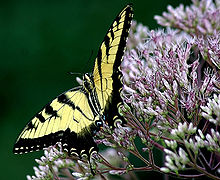| Eutrochium fistulosum | |
|---|---|

| |
| Eutrochium fistulosum with a butterfly | |
| Scientific classification | |
| Kingdom: | Plantae |
| Clade: | Tracheophytes |
| Clade: | Angiosperms |
| Clade: | Eudicots |
| Clade: | Asterids |
| Order: | Asterales |
| Family: | Asteraceae |
| Genus: | Eutrochium |
| Species: | E. fistulosum |
| Binomial name | |
| Eutrochium fistulosum (Barratt) E.E.Lamont | |
| Synonyms | |
| |
Eutrochium fistulosum (Eupatorium fistulosum), also called hollow Joe-Pye weed, trumpetweed, or purple thoroughwort, is a perennial North American flowering plant in the family Asteraceae. It is native to southern Canada and throughout the eastern and south central United States from Maine west to Ontario, Wisconsin, and Missouri and south as far as Florida and Texas. The specific name fistulosum refers to the tubular stem; see fistula.
Eutrochium fistulosum is a herbaceous perennial plant sometimes as much as 350 cm (140 in; 11 ft 6 in) tall. It is found in moist, rich soil alongside ditches and marshes, or in wet forests. It flowers from mid-summer to the first frosts, makes an attractive backdrop in garden plots, and is very attractive to butterflies, bees, and other nectar-feeding insects. In addition, it is a larval host to the Clymene moth, eupatorium borer moth, ruby tiger moth, and the three-lined flower moth.
The plant has one simple erect stem, which is green with purple dots or longitudinal dashes and can grow over six feet tall. The upper stems are reddish or purplish. Leaves and primary subdivisions of the flower head appear in whorls of 3–5 (rarely 2 or 6, the rotational symmetry of most plants is consistent). Leaves are large, long and sharply toothed. One plant can produce several flower heads in a branching array, each head with 4-7 pink or purple disc flowers but no ray flowers.
References
- "Eutrochium fistulosum (Barratt) E.E.Lamont". The Global Compositae Checklist (GCC). Retrieved 12 May 2015 – via The Plant List. Note that this website has been superseded by World Flora Online
- "Eutrochium fistulosum (Barratt) E.E. Lamont". Tropicos. Missouri Botanical Garden.
- ^ "Eutrochium fistulosum". Germplasm Resources Information Network. Agricultural Research Service, United States Department of Agriculture. Retrieved 9 June 2014.
- ^ Lamont, Eric E. (2006). "Eutrochium fistulosum". In Flora of North America Editorial Committee (ed.). Flora of North America North of Mexico (FNA). Vol. 21. New York and Oxford: Oxford University Press – via eFloras.org, Missouri Botanical Garden, St. Louis, MO & Harvard University Herbaria, Cambridge, MA.
- "Eutrochium fistulosum". County-level distribution map from the North American Plant Atlas (NAPA). Biota of North America Program (BONAP). 2014.
- Blanchan, Neltje (2005). Wild Flowers Worth Knowing – via Project Gutenberg Literary Archive Foundation.
- Tew, James Some Ohio Nectar and Pollen Producing Plants Archived 4 October 2006 at the Wayback Machine Ohio State University Extension Factsheet
- The Xerces Society (2016), Gardening for Butterflies: How You Can Attract and Protect Beautiful, Beneficial Insects, Timber Press.
| Taxon identifiers | |
|---|---|
| Eutrochium fistulosum |
|
| Eupatorium fistulosum | |
This Eupatorieae article is a stub. You can help Misplaced Pages by expanding it. |




